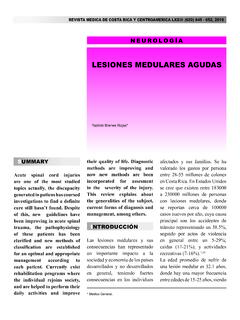Transcription of Guide to Critical Illness Cover - Legal & General
1 Guide TO Critical Illness Cover : DEFINITIONS EXPLAINED. 2 Guide TO Critical Illness Cover This Guide provides you with the full definition of the conditions covered by our Critical Illness plans. Please refer to your Policy Booklet to see exactly what you are covered for and any exclusions that may have been applied to your policy . Please note that where we refer to 'you' or 'your' in the following pages we are referring to the person/s whose life is covered by the plan. AORTA GRAFT SURGERY requiring surgical replacement POLICY DEFINITION WHAT DOES THIS MEAN? The undergoing of surgery to the aorta with excision and surgical replacement of a portion of the aorta with a graft. The term aorta includes the thoracic and abdominal aorta but not its branches.
2 For the above definition, the following are not covered : any other surgical procedure, for example the insertion of stents or endovascular repair. The aorta is the body s main artery carrying blood from the heart. This definition covers surgery to the aorta, where part of it is removed and replaced with a graft. Surgery may be needed to correct a weakening or bulging in the artery. It covers only the aorta, which is the main blood vessel in the chest and abdomen. This definition doesn t Cover the branches of the aorta. We Cover surgery for traumatic injury, as well as surgery following disease. APLASTIC ANAEMIA with permanent bone marrow failure POLICY DEFINITION WHAT DOES THIS MEAN? A definite diagnosis of aplastic anaemia by a consultant haematologist. There must be permanent bone marrow failure with anaemia, neutropenia and thrombocytopenia.
3 Aplastic anaemia is a rare but serious condition where bone marrow fails to produce sufficient blood cells or clotting agents. Symptoms include shortness of breath, excessive bleeding and an increased chance of catching infections. It can be life threatening if left untreated. 3 Guide TO Critical Illness Cover BACTERIAL MENINGITIS resulting in permanent symptoms POLICY DEFINITION WHAT DOES THAT MEAN? A definite diagnosis of bacterial meningitis by a hospital consultant resulting in permanent neurological deficit with persisting clinical symptoms*. For the above definition, the following are not covered: all other forms of meningitis other than those caused by bacterial infection. Bacterial meningitis causes inflammation to the meninges, which is the protective layer around the brain and spinal cord .
4 It s caused by a bacterial infection and needs prompt medical treatment. Initial symptoms include headache, fever and vomiting. If left untreated, it can result in brain damage or death. Some people will recover completely, while others will be left with permanent symptoms, which may affect their mobility or use of senses. This definition only covers people left with permanent symptoms. This definition covers the bacterial form of meningitis. It excludes all other forms of meningitis - like viral meningitis, which is usually milder. * See page 21 4 Guide TO Critical Illness Cover BENIGN BRAIN TUMOUR resulting in either surgical removal or permanent symptoms POLICY DEFINITION WHAT DOES THIS MEAN? A non-malignant tumour or cyst originating from the brain, cranial nerves or meninges within the skull, resulting in either surgical removal or permanent neurological deficit with persisting clinical symptoms*.
5 For the above definition, the following are not covered: tumours in the pituitary gland; tumours originating from the bone tissue; angioma and cholesteatoma. A benign brain tumour is a non-cancerous abnormal growth of tissue that can increase in size and cause pressure in the brain. Symptoms may vary depending on where the tumour is but may include headaches, seizures and blurred vision. Surgery to remove the tumour might be possible and once removed they tend not to recur. However, surgery isn t always an option due to the size or location of the tumour. This definition covers surgical removal of a tumour (whether permanent neurological symptoms persist or not) and tumours where surgery has not been performed but which result in permanent neurological symptoms.
6 This definition doesn t Cover tumours in the pituitary gland (a small gland within the brain) and angiomas (a benign tumour of blood vessels). * See page 21 BLINDNESS permanent and irreversible POLICY DEFINITION WHAT DOES THIS MEAN? Permanent and irreversible loss of sight to the extent that even when tested with the use of visual aids, vision is measured at 6/60 or worse in the better eye using a Snellen eye chart. This means permanent loss of vision. It s measured with a Snellen eye chart: the chart commonly used by opticians, which consists of a gradually decreasing series of letters and numbers. 6/60 vision means you can only read a letter or number at six metres that a person with normal vision can read at 60 metres. To claim, your vision must be 6/60 or worse in your better eye.
7 This definition doesn t Cover temporary blindness. 5 Guide TO Critical Illness Cover CANCER excluding less advanced cases POLICY DEFINITION WHAT DOES THIS MEAN? Any malignant tumour positively diagnosed with histological confirmation and characterised by the uncontrolled growth of malignant cells and invasion of tissue. The term malignant tumour includes leukaemia, sarcoma, pseudomyxoma peritonei, merkel cell cancer and lymphoma except cutaneous lymphoma (lymphoma confined to the skin). For the above definition, the following are not covered: All cancers which are histologically classified as any of the following: pre-malignant; non-invasive; cancer in situ; having either borderline malignancy; or having low malignant potential. All tumours of the prostate unless histologically classified as having a Gleason score of 7 or above or having progressed to at least clinical TNM classification T2bN0M0.
8 Malignant melanoma unless it has been histologically classified as having caused invasion beyond the epidermis (outer layer of skin). Any other skin cancer (including cutaneous lymphoma) unless it has been histologically classified as having caused invasion in the lymph glands or spread to distant organs. Cancer (also known as a malignant tumour) is a disease where normal cells change and grow in an abnormal way. If left untreated, they can destroy surrounding healthy cells and eventually destroy healthy cells in other parts of the body. There are about 200 different types of cancer, varying widely in outlook and treatment. Some cancers are not covered by this definition. These tend to be ones that have not yet spread or are localised and can usually be successfully treated.
9 Examples of these include some skin cancers and early stage prostate cancer. 6 Guide TO Critical Illness Cover CARDIAC ARREST with insertion of a defibrillator POLICY DEFINITION WHAT DOES THAT MEAN? Sudden loss of heart function with interruption of blood circulation around the body resulting in unconsciousness, requiring resuscitation and resulting in either of the following devices being surgically implanted: implantable cardioverter-defibrillato r (ICD); or cardiac resynchronisation therapy wit h defibrillator (CRT-D) .For the above definition, the following are not covered: insertion of a pacemaker ; insertion of a defibrillator withou t cardiac arrest ; or cardiac arrest secondary to illegal drug A cardiac arrest is when your heart suddenly stops pumping blood around your body, commonly caused by abnormal heart rhythm.
10 When your heart stops pumping blood, your brain is starved of oxygen. This causes you to fall unconscious and stop breathing. For this definition cardiac arrest must have occurred and resulted in insertion of a defibrillator. A defibrillator is a device which is implanted under the skin and regulates and restores normal heart rhythm by producing electric shocks to the heart when required. CARDIOMYOPATHY of specified severity POLICY DEFINITION WHAT DOES THIS MEAN? A definite diagnosis of cardiomyopathy by a consultant cardiologist. There must be clinical impairment of heart function resulting in the permanent loss of ability to perform physical activities to at least Class 3 of the New York Heart Association's classification of functional capacity . For the above definition, the following are not covered: cardiomyopathy secondary to alcohol or drug intake; all other forms of heart disease, heart enlargement and myocarditis.














